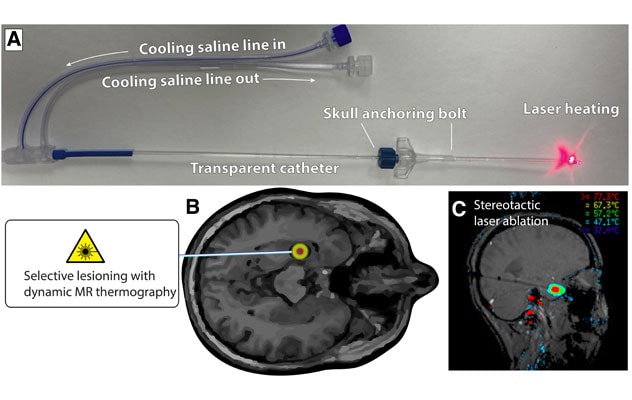May 25, 2022
Minimally invasive treatment

Minimally invasive treatment
Illustration depicts laser interstitial thermal therapy (LITT). A. A skull-anchoring bolt is placed through a small hole in the skull. A transparent catheter is threaded through the hole and into a target in the brain. B. Selective lesioning of the brain is performed in an MRI scanner, heating only the deep target without injuring the surrounding brain. C. Specialized MRI sequences generate real-time temperature maps, which clinicians monitor carefully during heating.
Mayo Clinic has the multidisciplinary expertise required to provide state-of-the-art laser interstitial thermal therapy (LITT). As an early adopter of LITT, Mayo Clinic has experience applying this minimally invasive option to the treatment of a wide range of epilepsies and brain tumors.
"We have multiple surgeons who are experts at the stereotactic techniques used in LITT. Our integrated practice incorporates expert neuroradiologists with these treatments as well," says Jamie J. Van Gompel, M.D., a neurosurgeon at Mayo Clinic in Rochester, Minnesota.
LITT avoids the neurological, neuropsychological and procedure-related complications of open surgery.
"The most significant benefit is the ability to reach deep-seated lesions without damaging surrounding brain tissue," says Kai J. Miller, M.D., Ph.D., a neurosurgeon at Mayo Clinic's campus in Minnesota. "Patient recovery is much shorter, and we avoid the cosmetic issues associated with large incisions and muscle wastage. In our experience, some individuals with epilepsy who decline an open resection do choose to undergo LITT."
Multiple applications
Mayo Clinic neurosurgeons most commonly use LITT to treat deep-seated lesions in temporal lobe epilepsy. To avoid complications with verbal memory, Mayo Clinic performs the procedure most commonly for left-sided temporal lobe epilepsy.
Other epileptic conditions treated with LITT include:
- Encephaloceles
- Epileptogenic tissue aberrancies, such as focal cortical dysplasia, gray matter heterotopia and cortical tubers
- Epileptogenic brain tumors, such as neuroglial tumors and gangliogliomas
- Hypothalamic hamartomas
Corpus callosotomy for the treatment of intractable tonic and atonic "drop attack" seizures can also be performed with LITT. "Laser callosotomy is significantly less invasive than open callosotomy, which involves craniotomy, dissection and brain retraction," Dr. Miller says.
LITT is typically slightly less successful than open surgery. For example, the success rate for LITT treatment of mesial temporal lobe epilepsy is about 50% to 60%.
"For that reason, we don't think of LITT as a replacement treatment. We think of it as a first step," Dr. Van Gompel says. "If it doesn't work, then we go on to the treatment that has a higher chance of effectiveness but also a higher chance of side effects."
For individuals with brain cancer, Mayo Clinic uses LITT to treat radiation-induced necrosis and tumors that are radiation resistant or located in areas difficult to treat, such as a thalamus.
"At Mayo Clinic we have also used LITT to provide palliative treatment for skull base tumors," Dr. Van Gompel says.
As a major neurological center, Mayo Clinic participates in clinical trials of ablation technology. Mayo Clinic's expertise with LITT was recognized when Dr. Van Gompel was invited to perform the procedure in Sweden for an individual with mesial temporal epilepsy. LITT isn't widely used in Europe.
"The procedure went very well," Dr. Van Gompel says. "Mayo Clinic is committed to sharing high-quality patient care across the world."
For more information
Refer a patient to Mayo Clinic.